#victoria roberts animation
Explore tagged Tumblr posts
Text
Victoria Roberts Talks about Animation.
Today's interview on Case is a little bit different—I had been seeing Victoria's lovely animations on Instagram, and asked her if she might be interested in talking about them on here. She kindly obliged, so I sent her a loose list of questions to consider, and she sent me back such an incredible rumination on her experiences that I replied back to her "This is so cool! You are so cool!" because though I was expecting something incredible (Victoria being Victoria after all!), it wouldn't be dramatic for me say that I was thunderstruck! Anyways, I hope you all enjoy reading what she has to say as much as I did! —Jane
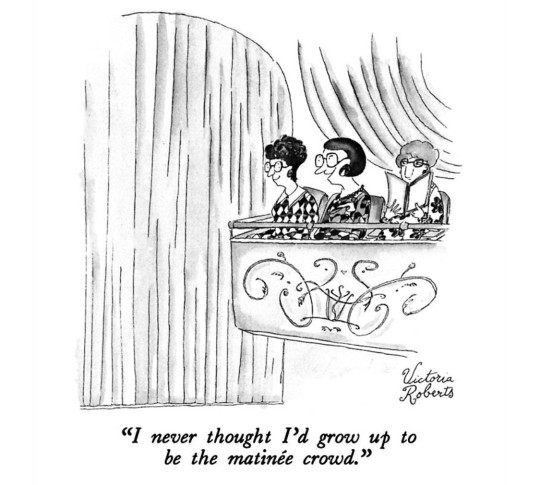
Find this print here!

On Animation
I’m so fortunate to be working on what I love.
It’s been a long haul in a way. I came to New York City from Sydney, Australia, because I wanted to run away with the Wooster Group-that is, do theatre. Or film. I was already a cartoonist, and I became one under contract to The New Yorker, an enormous privilege, thirty odd years ago.
But since last month, thanks to a software named Callipeg, I make an animated short every week, for which I do the voices, called “Axolotl Mondays.” Finally, I’m in the movies!
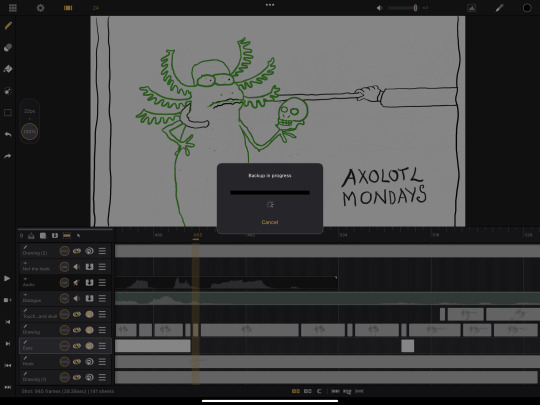
To be a performer and tell stories, or at least vignettes, is my passion. At nineteen, with $5000 from the Creative Development Fund of The Australia Council, we made “Goodbye Sally Goldstein”, a five minute animated film. I had three collaborators:
Rob Rogers, composer and musician, Kathryn Pentecost, and Jacqueline Field who drew and painted. From the sound recording, inking and painting, to the shoot, it took six months to complete. My favourite task in all of this was doing the sound breakdown, which consisted of manually running the soundtrack tape through a reader (not sure what the device was called) and jotting down the length of each sound so that you could animate to the soundtrack.
David Deneen founder of Film Graphics was my inspiration and coach. What I knew about animation came from time spent over the school holidays in his studio thanks to my mum, who worked in advertising and got me the gig. They were making an animated ad for Witchy Brew, an ice cream, and I remember they said it wasn’t until they boiled spaghetti that they got the right sound for the witch’s cauldron.
Every animator had a different style, and each animator’s desk, covered in drawings, felt like a different universe. Val Udowenko and Don Mackinnon were stars in this creative shop that went on to win the Academy Award for Bruce Petty’s “Leisure” in 1976, Best Short Film. To watch David Deneen solve a problem from idea, to script, to film, was my university.
I left school at sixteen and got a job painting cels for Hannah Barbera. The studio was run by Zoran Janjic, and his mum Zora, ran the painting department. Her “quiet girls please!” in a rich Yugoslavian accent resounded often. It was a big studio.
Sometimes we were on a network deadline so tight that Bill Hannah came to Sydney. We were paid per painted cel, working overtime, and we would try to get scenes with many mouths, as lips were very quick to paint. We stayed in over lunchtime and Mr. Hannah ordered in for us, fried chicken and coleslaw. “Would anybody like more slaw?” he offered, and the painting department cracked up at his American pronounciation of “slaaaaaaaaaaw.”
Again I had the good fortune to hear the soundtrack for a series called “Wait ‘til Your Father Comes Home,” an animated sitcom. I loved the soundtracks, and again remember the sound more than the drawings, and longed to be a creator of some sort.
Some characters come to the world with more dialogue than others. A cartoon strip though roomier than a gag cartoon with a drawing and one line of dialogue, isn’t enough space still for some characters like Nona Appleby, an Australian octogenarian character I have drawn since I was 16. Finally I started to play her on stage, and that gave Nona the opportunity to say everything that is in her heart (it’s a lot!). I maintain that I am a vessel, and the characters do all of the work.
“Axolotl Mondays” is mid-step between the page and theatre. There is the element of time in a video, which is delicate and wonderful. A friend gave me gift of a six week editing course at MEWSHOP in New York City, which gave me a very good base for cutting and thinking about time. We learned at one of their lectures that “Annie Hall” started out as a film with a stream of consciousness dialogue, but that Diane Keaton’s performances were so extraordinary that it became another film in the editing room. I mention this to underline the malleability, possibility and difficulty of film.
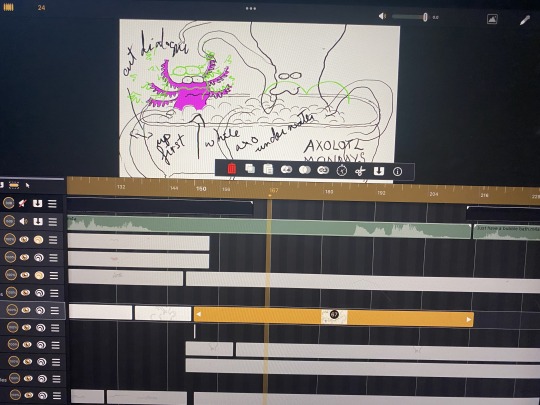
These videos start out with a soundtrack usually, but I learn something new each week about how movement and time on screen works. My animation style is very basic, which fortunately suits my drawing style. It’s detail and timing, and other possibilities which I am learning about that make a piece “sing.” As with most of my work, I rarely know what I am doing. It’s the mystery, the discovery, that keep me on board.
Callipeg is like having an old-style animation studio at your fingertips. Everything is done on the iPad. It’s so much faster than paper and cels, and cameras-and so accessible. Really a beautiful software, plus the creator’s tutorials are delivered in a native French accent!
Instagram Links:
Kathryn Pentecost is at BohemianPalaceof Art
Rob Rogers is rogers_bob
Jacqueline Field
Don Mackinnon
———-
If you enjoy this blog, and would like to contribute to labor and maintenance costs, there is a Patreon, and if you’d like to buy me a cup of coffee, there is a Ko-Fi account as well! I do this blog for free because accessible arts education is important to me, and your support helps a lot! You can also find more posts about art supplies on Case’s Instagram and Twitter! Thank you!
#artists on tumblr#victoria roberts cartoonist#victoria roberts#animation#victoria roberts animation
15 notes
·
View notes
Text










Prophecy (1979)
"It's a mutagen."
"A mutagen, what is that?"
"Freakism! Freakism, that's what's been going on out there. That's why there's a goddamn salmon five feet long, and a tadpole the size of what a bullfrog should be!"
#prophecy#1979#horror imagery#american cinema#horror film#john frankenheimer#david seltzer#talia shire#robert foxworth#armand assante#richard dysart#victoria racimo#george clutesi#charles h. gray#tom mcfadden#burke byrnes#mia bendixsen#johnny timko#graham jarvis#leonard rosenman#enjoyably over the top in its late stage carnage and grue‚ and appropriately handsomely shot elsewhere for an eco horror#that's (at least purportedly) as concerned with conservation as it is with mainstream horror stuff. someone's polluting the water and now#the beasties are turning huge and murderous and rubbery. facing it all down is Bob Foxworth's ecological inspector and his wife‚ plus a#native American tribe led by‚ uhh‚ Armand Assante. that in particular is a tone deaf and disappointing casting decision and one of two#major issues this film has; the other is at least one scene of genuine animal cruelty which‚ in a film that's supposed to be about#respecting the natural environment‚ it's not only needless and inhumane‚ it's truly galling. so kind of hard to recommend the film on those#two points‚ but if you can get past them (and why should you? but if you can) this is a fairly entertaining bit of 70s monster slop#Frankenheimer made a clutch of incredible‚ challenging films‚ but he also made some rubbish; this skews more toward the latter than the#former‚ truth be told‚ but his scenic work here is beautiful and the natural landscape shines
1 note
·
View note
Text
List of free audiobooks on YouTube for anyone interested
The Hunger Games by Suzanne Collins
Pride & Prejudice by Jane Austen
The Great Gatsby by F. Scott Fitzgerald
Diary of a Wimpy Kid by Jeff Kinney
The Adventures of Tom Sawyer by Mark Twain
Alice in Wonderland
Animal Farm by George Orwell
The Shadow Over Innsmouth by H P Lovecraft
Frankenstein by Mary Shelley
Crime and Punishment by Fyodor Dostoyevsky
Hatchet by Gary Paulsen
Twelve Years a Slave by Solomon Northup
Of Mice and Men by John Steinbeck
The Village by Caroline Mitchell
The Wonderful Wizard of Oz
Harry Potter and the Philosopher’s Stone (fuck JKR)
Sense & Sensibility by Jane Austen
The Handmaid’s Tale by Margaret Atwood
Twilight by Stephanie Meyer
Upside Down by Danielle Steel
The Fiancée by Kate White
The Silence of the Lambs by Thomas Harris
Percy Jackson & the Olympians: The Lightning Theif
Accidentally Married by Victoria E. Lieske
I’m Glad My Mom Died by Jennette McCurdy
The Collector (book one) by Nora Roberts
The Lies I Told by Mary Burton
Dead Man’s Mirror by Agatha Christie
The Hobbit
The Taken Ones by Jess Lourey
The Good Neighbour by R J Parker
The Island House by Elana Johnson
Desperation by Stephan King
The Healing Summer by Heather B. Moore
The Last Affair by Margot Hunt
To Be Claimed by Willow Winter
Romeo and Juliet by Shakespeare
The Hitchhiker’s Guide to the Galaxy
The Inn by James Patterson
Wonder by R J Palacio
Faking It With The Billionaire by Willow Fox
The Lost Years by Mary Higgins Clark
Forrest Gump by Winston Groom
The Janson Directive by Robert Ludlum
The Catcher in the Rye
The Lottery Winner by Mary Higgins Clark
Where Eagles Dare by Alistair MacLean
Death of a Nurse by M C Beaton
Yours Truly by Abby Jimenez
Treasure Island by Robert Louis Stevenson
The Sonnets by William Shakespeare
Frozen Betrayal by Clive Cussler
The Picture of Dorian Gray by Oscar Wilde
Line of Fire by R J Patterson
Don’t Believe Everything You Think by Joseph Nguyen
The Remnant by Tim LaHaye
The Magic of Reality by Richard Dawkins
The Secret of Chimneys by Agatha Christie
Payment in Kind by J A Jance
The Idiot by Fyodor Dostoyevsky
The Way of the Superior Man by David Deida
The Game of Life and How to Play It by Florence Scovel Shinn
The Richest Man in Babylon by George S. Clason
To Kill a Mockingbird by Harper Lee
A Marriage of Anything but Convenience by Victorine E. Lieske
The Adventures of Huckleberry Finn by Mark Twain
A Christmas Carol by Charles Dickens
The Inheritance Game by Jennifer Lynn Barnes
Ikigai: The Japanese Secret to a Long and Happy Life
Thinking Fast and Slow by Daniel Kahneman
How to Win Friends and Influence People by Dale Carnegie
The Kama Sutra by Mallanaga Vatsyayana
The Wisdom of Father Brown by G K Chesterton
Robinson Crusoe by Daniel Defoe
Robin Hood by J Walker McSpadden
The Poor Traveller by Charles Dickens
Days on the Road: Crossing the Plains in 1865 by Sarah Raymond Herndon
Oliver Twist by Charles Dickens
Atomic Habits by James Clear
I Have No Mouth, and I Must Scream
Trading in the Zone by Mark Douglas
The Art of War by Sun Tzu
The Secret Garden by Frances Hodgson Burnett
A Short History of Nearly Everything by Bill Bryson
The Return of Sherlock Holmes by Arthur Conan Doyle
The Epic of Gilgamesh
Lord of the Flies by William Golding
A Tale of Two Cities by Charles Dickens
Man After Man
Five on a Treasure Island by Enid Blyton
The Red Badge of Courage by Stephen Crane
Charlotte’s Web
Midsummer Mysteries by Agatha Christie
Out of Silent Planet by C S Lewis
The Valley of Fear by Arthur Conan Doyle
Eaters of the Dead by Michael Crichton
The Murder on the Orient Express by Agatha Christie
The Castle of Otranto by Horace Walpole
21 Lessons for the 21st Century by Yuval Noah Harai
Hamlet by Shakespeare
#mental health#positivity#self care#mental illness#self help#recovery#ed recovery#pro recovery#study#study affirmations#studying#studyblr#school#free#audiobooks#YouTube#piracy#bookblr#books#reading#long reads#comfort#meditation#book#study resources#web resources#lizzy grant#poetry#motivation#self love
104 notes
·
View notes
Text
what we know: The Acolyte was pitched sometime in early 2020. The Rise of Skywalker had just ended the movie saga. The Mandalorian, which kicked off disney+, had just finished its first season with great audience response. Lucasfilm was reorienting itself to streaming. Rayne Roberts loved the pitch, got Kathleen Kennedy who also loved it, and the show was greenlit.
the show premiered in summer 2024, after a generous marketing campaign (including a clip shown with The Phantom Menace rerelease, an original Victoria Monét song, and plenty of trailers and tv spots). multiple pieces of tie-in media were announced both before and during the show's airing (an Acolyte comic issue, a Kelnacca comic issue, a visual guide, an art reference book, two novels featurig show characters).
the high republic multimedia project (THR), in advanced development when the show was pitched and published continuously from early 2021, greatly influenced the show's development. the costuming is largely based on the look of THR, the show makes plenty of lore references, and includes a main character from the books in its main cast. THR material coming out in summer 2024 has "a century before The Acolyte" prominently on the cover, the upcoming show tie-ins are largely written by THR authors, and often feature other THR characters.
the show was expensive, with a long production period and a great focus on the technical aspects - building large elaborate sets, filming on location in Madeira, detailed stunt sequences with a lot of actor involvement, plenty of attention given to costumes, make-up and creature design. the cast included many high-profile actors. everything suggests the show had full confidence of lucasfilm.
what i'm gonna speculate: lucasfilm was playing the long game with this show, or hoping to. cancelling the show this early was unexpected.
in 2019 star wars was quite literally centered on the original trilogy. the seven decades or so around the OT contained all currently canon star wars media, even as the franchise was spoken of as one with 25,000 years of history. the following years would plug up even more empty spots on the timeline, with the projects often overlapping. this gave the writers much less creative freedom, which was the whole point of decanonizing all pre-2014 media aside from films and shows. over time, fans started clamoring for onscreen content set outside of the known eras, and there were more and more voices in and outside of the fandom exhausted with fanservice (the glup shitto phenomenon).
The Acolyte was set in a whole new era, as far as onscreen content goes, and its only legacy character was from children's and YA books most viewers wouldn't be familiar with. it was specifically introduced as a show you wouldn't need any homework for. it had actors prominent in entirely different contexts (Matrix. sitcom. Squid Game. YA. superhero movies. independent films. relationship dramas.) and the cast was pretty international.
the show had a lot specifically for established fans - you could say it was the most wide-reaching in its star wars references, incorporating elements from every trilogy, the animated shows, canon books, oldschool legends lore, video games. but i believe it was mostly meant to attract people who were not previously fans, and especially target demographics that were underrepresented in the fandom. draw in international audiences, young people who were around for other star wars properties but they never caught their interest, women who either weren't in the fandom or felt pushed away by the reaction to The Last Jedi.
lucasfilm execs definitely weren't planning for viewing numbers comparable to Obi-Wan Kenobi, or even Ahsoka, since those are characters people are already invested in. i think lucasfilm expected the show's audience to grow over a longer period, since plenty of people might check it out because it seems cool and they like an actor in it, and hopefully stick around to watch other star wars and become new fans of the franchise. the audience would get a chance to establish itself through new viewers watching it outside the couple weeks when it aired originally - it's a streaming platform, after all - and the show would have a solid fandom for its second season (which they were clearly planning to make).
these new fans would keep disney+ in order to check out other star wars shows and film, and keep buying star wars stuff over the hiatus. even if they were only into The Acolyte and their interest never expanded beyond that, there were many merchandising products and tie-in materials coming out. the comics and books would have connections to THR, hopefully getting an influx of readers before the initiative finishes next year and boosting sales of already published works. the THR readers who weren't interested in the show originally would see all their favorite authors writing stuff for it and check it out, too.
but then someone higher up decided to cancel it a month after airing so no i guess
34 notes
·
View notes
Text
Another long post ahead, because I was thinking about what the audience wants to see vs what Emmerdale wants to show.
Fans: We don't want to see animal abuse on the show.
The show: Piper will be a continued focus in the story, this wouldn't be as much of an issue if we had picked an "uglier dog".
Fans: Please don't drag this Belle story out much longer.
The show: The story will go on for like another 6 months, i.e. it's only halftime really.
Fans: We don't like Vanessa and Suzy together.
The show: Vanessa and Suzy are moving in together.
Fans: But we want Charity and Vanessa back together.
The show: Charity is with her soulmate, Mackenzie.
Fans: Mary and Suzy have chemistry!
The show: Mary might get another love interest soon.
Fans: Please, no more (especially unplanned ones, it's 2024!) pregnancy storylines for a while!
The show: Ella will come back pregnant with Liam's baby.
Fans: But we liked Liam with Chas!
The show: See above answer.
Fans: We are interested to see what's next for Aaron, since you brought him back and built him a new set.
The show: Aaron will only appear in like 7 episodes between April and July. But then we might put him with Robert's brother.
Fans: It would be great if Seb was brought back to the village for Aaron to raise.
The show: Seb? We only mentioned him that one time to make Aaron understand that biological parents hurt more when children are taken away.
Fans: Good on Jai for getting revenge on evil Amit over Rishi's death, we loved Rishi.
The show: Jai will be punished, he's a bad person, he'll lose his wife and family over this.
Fans: Is Angel coming back with a new face after going to prison?
The show: No. Same face.
Fans: We need a bit more lighthearted stories.
The show: Lots of more hard hitting stories coming up still. We can certainly throw in some comical scenes featuring the show's best partnership Marlon and Paddy, or our best comedic performance winner, Mandy!
Fans: The show needs more Sugdens to counter all the Dingles.
The show: Ok, here is a new brother for Victoria (and Robert), but we'll make him gay, and the only other gay character in the village at this time is Aaron. But who will catch John's eye??
Fans: Would be cool if the show brought back some old characters for the 10 000th episode.
The show: We are honoring some past characters by dressing up scarecrows to look like them. You're welcome.
30 notes
·
View notes
Text
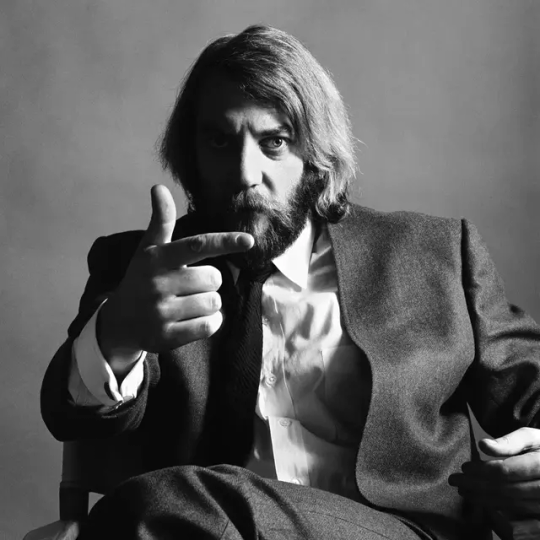
Donald Sutherland
Commanding and versatile actor known for his roles in MAS*H, Don’t Look Now and The Hunger Games
Donald Sutherland, who has died aged 88, brought his disturbing and unconventional presence to bear in scores of films after his breakthrough role of Hawkeye Pierce, the army surgeon in Robert Altman’s M*A*S*H (1970), one of the key American films of its period. It marked Sutherland out as an iconoclastic figure of the 60s generation, but he matured into an actor who made a speciality of portraying taciturn, self-doubting characters. This was best illustrated in his portrayal of the tormented parent of a drowned girl, seeking solace in a wintry Venice, in Nicolas Roeg’s Don’t Look Now (1973), and of the weak, nervous, concerned father of a guilt-ridden teenage boy (Timothy Hutton) in Robert Redford’s Ordinary People (1980).
Although Sutherland appeared in the statutory number of stinkers that are many a film actor’s lot, he was always watchable. His career resembled a man walking a tightrope between undemanding parts in potboilers and those in which he was able to take risks, such as the title role in Federico Fellini’s Casanova (1976).
Curiously, it was Sutherland’s ears that first got him noticed, in Robert Aldrich’s The Dirty Dozen (1967). During the shoot, according to Sutherland, “Clint Walker sticks up his hand and says, ‘Mr Aldrich, as a representative of the Native American people, I don’t think it’s appropriate to do this stupid scene where I have to pretend to be a general.’ Aldrich turns and points to me and says, ‘You with the big ears. You do it’ … It changed my life.” In other words, it led to M*A*S*H and stardom.
Sutherland and his M*A*S*H co-star Elliott Gould tried to get Altman fired from the film because they did not think the director knew what he was doing due to his unorthodox methods. In the early days, Sutherland was known to have confrontations with his directors. “What I was trying to do all the time was to impose my thinking,” he remarked some years later. “Now I contribute. I offer. I don’t put my foot down.”
Sutherland, who was born in Saint John, New Brunswick, Canada, was a sickly child who battled rheumatic fever, hepatitis and polio. He spent most of his teenage years in Nova Scotia where his father, Frederick, ran a local gas, electricity and bus company; his mother, Dorothy (nee McNichol), was a maths teacher. He attended Bridgewater high school, then graduated from Victoria College, part of the University of Toronto, with a double major in engineering and drama. As a result of a highly praised performance in a college production of James Thurber’s and Elliott Nugent’s The Male Animal, he dropped the idea of becoming an engineer and decided to pursue acting.
With this in mind, he left Canada for the UK in 1957 to study at Lamda (the London Academy of Music and Dramatic Art), where he was considered too tall and ungainly to get anywhere. However, he gained a year’s work as a stage actor with the Perth repertory company, and appeared in TV series such as The Saint and The Avengers. He was Fortinbras in a 1964 BBC production of Hamlet, shot at Elsinore castle and starring Christopher Plummer. He also appeared at the Criterion theatre in the West End in The Gimmick in 1962.
In 1959 he married Lois Hardwick; they divorced in 1966. Then he married the film producer Shirley Douglas, with whom he had twins, Kiefer and Rachel; they divorced in 1971. Kiefer, who grew up to become a celebrated actor, was named after the producer-writer Warren Kiefer, who put Sutherland in an Italian-made Gothic horror film, The Castle of the Living Dead (1964). Christopher Lee played a necrophile count, while Sutherland doubled as a dim-witted police sergeant and, in drag and heavy makeup, as a witch.
In an earlier era, the gawky Sutherland might not have achieved the stardom that followed the anarchic M*A*S*H, but Hollywood at the time was open for stars with unconventional looks, and Sutherland was much in demand for eccentric roles throughout the 70s.
He was impressive as a moviemaker with “director’s block” in Paul Mazursky’s messy but interesting Alex in Wonderland (1970), which contains a prescient dream sequence in which his titular character meets Fellini. In the same year, Sutherland played a Catholic priest and the object of Geneviève Bujold’s erotic gaze in Act of the Heart; he was the appropriately named Sergeant Oddball, an anachronistic hippy tank commander, in the second world war action-comedy Kelly’s Heroes; and he and Gene Wilder were two pairs of twins in 18th-century France in the broad comedy Start the Revolution Without Me.
Sutherland was at his most laconic, sometimes verging on the soporific, in the title role of Alan J Pakula’s Klute (1971), as a voyeuristic ex-policeman investigating the disappearance of a friend and getting deeply involved with a prostitute, played by Jane Fonda.
Sutherland and Fonda were teamed up again as a couple of misfits in the caper comedy Steelyard Blues (1973). It initially had a limited distribution due mainly to their participation together in the anti-Vietnam war troop show FTA (Fuck the Army), which Sutherland co-directed, co-scripted and co-produced.
Sutherland always made his political views known, although they surfaced only occasionally in his films. In among the many mainstream comedies and thrillers was Roeg’s supernatural drama Don’t Look Now, in which Sutherland and Julie Christie are superb as a couple grieving their dead daughter. Despite the dark subject matter, the film was notable for containing “one of the sexiest love scenes in film history”, according to Scott Tobias in the Guardian, the frank depiction of their love-making coming “like a desert flower poking through concrete”. The actor so admired Roeg that he named another son after him, one of his three sons with the French-Canadian actor Francine Racette, whom he married in 1972.
John Schlesinger’s rambling version of The Day of the Locust (1975) saw Sutherland as a sexually repressed character – called Homer Simpson – who tramples a woman to death in an act of uncontrolled rage. Perhaps Bernardo Bertolucci had that in mind when he cast Sutherland in 1900 (Novecento, 1976), in which he is a broadly caricatured fascist thug who shows his sadism by smashing a cat’s head against a post and bashing a young boy’s brains out. “And I turned down Deliverance and Straw Dogs because of the violence!” Sutherland recalled.
In Fellini’s Casanova, the second of his two bizarre Italian excursions in 1976, Sutherland coldly calculates seduction under his heavily made-up features. The performance, as remarkably stylised as it is, still reveals the suffering soul within the sex machine.
In 1978 he appeared in Claude Chabrol’s Blood Relatives, a made-in-Canada murder mystery with Sutherland playing a Montreal cop investigating the murder of a young woman. More commercial was The Eagle Has Landed (1976), with Sutherland, attempting an Irish accent, as an IRA member supporting the Germans during the second world war, and as a chilling Nazi in Eye of the Needle (1981). Meanwhile, he was the hero of Invasion of the Body Snatchers (1978), who resists the insidious alien menace until the film’s devastating final shot.
In 1981 Sutherland returned to the stage, as Humbert Humbert in a highly anticipated version of Vladimir Nabokov’s Lolita, adapted by Edward Albee. It turned out to be a huge flop, running only 12 performances on Broadway. Both Sutherland and Albee played the blame game. “The second act is flawed,” Sutherland said. “Albee was supposed to have rethought it, but he never did.” Albee told reporters that he had scuttled some of his best scenes because they were “too difficult” for Sutherland because “he hasn’t been on stage for 17 years”.
Continuing his film career, Sutherland played a complex and sadistic British officer in Hugh Hudson’s Revolution (1985), and in A Dry White Season (1989) he took the role of an Afrikaner schoolteacher beginning to understand the brutal realities of apartheid. In Oliver Stone’s JFK (1991), he held the screen with an extended monologue as he spilled the conspiracy beans to Kevin Costner’s district attorney hero Jim Garrison.
After having made contact with young audiences in the 70s with offbeat appearances in gross-out pictures The Kentucky Fried Movie (1977) and National Lampoon’s Animal House (1978), the latter as a pot-smoking professor, he was cast as an unconvincing bearded stranger in Buffy the Vampire Slayer (1992).
On a more adult level were Six Degrees of Separation (1993), in which he played an unfulfilled art dealer; A Time to Kill (1996), as an alcoholic, disbarred lawyer (alongside Kiefer); Without Limits (1998), as an enthusiastic athletics coach; and Space Cowboys (2000), as an elderly pilot. By this time, he was gradually moving into grey-haired character roles, one of the best being his amiable Mr Bennet in Pride and Prejudice (2005).
The Jane Austen novel was also featured in the television series Great Books (1993-2000), to which Sutherland lent his soothing voice as narrator. Other series in which he shone as quasi baddies were Commander in Chief (2005) – as the sexist Republican speaker of the house opposed to the new president (Geena Davis) – and Dirty Sexy Money (2007-09), in which he played a powerful patriarch of a wealthy family.
Sutherland continued to be active well into his 80s, his long grey hair and beard signifying sagacity, whether as a contract killer in The Mechanic, a Roman hero in The Eagle, a nutty retired poetry professor in Man on the Train (all 2011), or a quirky bounty hunter in the western Dawn Rider (2012), bringing more depth to the characters than they deserved. As President Coriolanus Snow, the autocratic ruler of the dystopian country of Panem in The Hunger Games (2012), Sutherland was discovered by a new generation; he went on to reprise the role in three further films in that franchise, beginning with The Hunger Games: Catching Fire (2013).
He played artists in two art-world thrillers by Italian directors: in Giuseppe Tornatore’s Deception, AKA The Best Offer (2013), he was a would-be painter helping to execute multimillion-dollar scams, while in Giuseppe Capotondi’s The Burnt Orange Heresy (2019) he was on the other side of the heist as a reclusive genius targeted by a wealthy and unscrupulous dealer (Mick Jagger).
Aside from James Gray’s science-fiction drama Ad Astra (also 2019), in which he co-starred with Brad Pitt, Sutherland’s best late work was all for television. In Danny Boyle’s mini-series Trust (2018), which covered the same real-life events as Ridley Scott’s All the Money in the World, he played J Paul Getty, the oil tycoon whose grandson is kidnapped; while in The Undoing (2020), he was the father of a psychologist (Nicole Kidman), reluctantly putting up bail when her husband (Hugh Grant) is arrested for murder.
For the latter role Sutherland was in the running for a Golden Globe, having already received an honorary Oscar in 2017.
He is survived by Francine and his children, Kiefer, Rachel, Rossif, Angus and Roeg, and by four grandchildren.
🔔 Donald McNichol Sutherland, actor; born 17 July 1935; died 20 June 2024
Daily inspiration. Discover more photos at Just for Books…?
51 notes
·
View notes
Text
Legendary Creatures: Bunyip

By Henry Dowling, John Murray - Reproduced from The Tasmanian Journal of Natural Science [1], Public Domain, https://commons.wikimedia.org/w/index.php?curid=3275930
Wet places, especially places that remain wet most, if not all, of the year give rise to many legendary creatures. To the Wemba-Wemba Aboriginal people of southeast Australia, near modern-day Victoria, the bunyip was one of them.

By Gerald Markham Lewis - http://nla.gov.au/nla.pic-an21971935, Public Domain, https://commons.wikimedia.org/w/index.php?curid=1805519
The word bunyip is usually translated as 'devil' or 'evil spirit' but the creature itself and its role for the Aboriginal people was more complex than those translations allow. There's also an apparent linguistic connection to Bunjil, who was 'a mythic 'Great Man' who made the mountains, rivers, man, and all the animals'. While the name comes from the Wemba-Wemba people, there are variations of the bunyip throughout Australia with Robert Holden identifying at least nine variations in his 2001 book Bunyips: Australia's Folklore of Fear.

By Macfarlane, J. - https://viewer.slv.vic.gov.au/?entity=IE7218367&mode=browse, Public Domain, https://commons.wikimedia.org/w/index.php?curid=1816013
The bunyip is usually aquatic or amphibious, living in the lakes, swamps, rivers, lagoons, billabongs, and other bodies of water. The Moorundi people of Murray River describe it as as written in a description by George French Angus,'It inhabits the Murray; but … they have some difficulty describing it. Its most usual form … is said to be that of an enormous starfish'. There used to be an outline of a bunyip that until the mid-1850s was visited annually to be retraced by Aboriginal People in the banks of Fiery Creek near modern-day Ararat, Victoria, that was only described as '11 paces long and 4 paces in extreme breadth' by The Australasian newspaper in 1851. In 1878, Robert Brough Smyth wrote in his Aborigines of Victoria that 'in truth little is known among the blacks respecting its form, covering or habits; they appear to have been in such dread of it as to have been unable to take note of its characteristics'. It is also described as having an morepoke owl's snout and probably nocturnal.
The origin of the bunyip is also debated and murky. Some think the origin is seals making their way up-river where they're not usually seen. Others think that it is a cultural memory of some extinct marsupial or possibly fossils. Still others say that it might be the southern cassowary as it seems to match the description of the Aboriginal people in Far North Queensland. Others say it might be the Australasian bittern as the male's mating call sounds like a 'low pitched boom'.
15 notes
·
View notes
Text
HC Snippets: Big Waves' Sydney Trio
...I'll admit that @//hachiiware's ask left me wanting to go on detail about other BW families other than Quincy's; so here's a compilation of my ideas for the main three.

Like I've said, Nice, Jean and Reef all live in Sydney, and attend the same school and soccer team. This is also where Robert teaches, all too convenient.
Though there's just one detail to address, that Jean was born in Victoria. After a certain family incident his mother preferred to start a new life in Sydney instead.
Nice and Jean met at the beach by a curious encounter. One typical day where his caregiver took him to the beach, Jinbei saw a blonde boy practising surf alongside his father. Impressed by the sport, he decided to combat his shyness and approach him. Despite the surprise, Nice acted friendly enough with the mysterious child, even inviting him to learn surf too. Such fun afternoon would be the start of a great friendship.
From there on, Nice and Jean would invite each other to their homes, or in some cases they'd go to his caregiver's house to watch his anime collection (Even if Nice was weirded out by the japanese cartoons). Around the time of Primary School, both boys got interested on soccer and started to practice together. Thanks to their dedication (And perhaps some potential within them), the two completely killed it once they entered the world of Secondary School/Junior High soccer; carrying their team to the finals. They might have lost aganist a team from Queensland, sure, but nothing too bad.
On their second year it would be when things got a sudden twist with the entrance of Reef Hamilton to their school, team... And friend group.
Reef had an entirely different upbringing than them. His father was the owner of a popular hotel chain across eastern australia, so he would always go into vacation somewhere new. But although he was able to meet new faces everytime, Reef preferred to isolate himself, enjoying to be at the beach. And with the teachings of his mother -a diving instructor-, that meant also spending most of his time underwater. Even when it wasn’t summertime Reef would be seen apart from the other kids.
Even if his parents tried to set his child to interact with others many times, Reef overall seemed to have problems on forging and continuing conversations, which started to raise some concerns. Just to make sure they decided to investigate a bit, and soon enough they found out their child was on the Autism Spectrum. Understanding now and accepting what their son had, they assigned him a therapist as means to help him in life, but still prioritizing his own wishes.
For a long time Reef's interests had been only about marine biology, leading to him writing entire pages about the fish he'd see on vacation. But after seeing Nice and Jean's performance on TV, he would soon develop interest on soccer. And soon he'd meet Robert Cliser, local counselor and a huge lover of the sport, who offered himself to help Reef integrate to the team while also training it.
So yeah, things went well. Reef's fun yet clever atitude blended with the two sea bros, making a well addition to their friend group. Nice and Reef were quick to bond, but with Jean it had its difficulty. What ended up uniting him however was none than Jean's mother, Bea Baker. Her being a former marine biologist soon caught Reef's attention, making him visit her small bakery weekly. The two players got soon used to each other eventually, specially since Jean did like sealife too.
Bea likes to consider Reef a second son, but Jean doesn't feel fond of that.
Now, let's talk about the Great Barrier Reef. The hissatsu, I mean. I like to attribute its origin to the fondness for the sea the trio had. Since his early beginnings in soccer Jean liked to use the sea to hone his skills, and the idea of using marine wildlife to defend the goal didn't seem that bad. So since his first years he had been working on it, but Reef's dedication and knowledge of the actual barrier helped to polish it better. Nowadays GBR is the most powerful keeper hissatsu Australia has to offer, but also a love letter to the country's natural wonder. Whenever someone uses it, Reef feels very happy.
...I guess that's the important stuff. Outside of soccer, the three like to play other sports such as beach voleyball, bowling, and surfing obviously. Jean leans it more into windsurfing but y'know, still fits.
Joe Jones/Jaws is the fourth wheel of this friend group but I'll touch it later on.
Bonus regarding adulthood; but post FFI Nice and Jean kept playing soccer, till he got into the more professional world. Reef played gladly until soccer, but a certain self-reflection he had made him instead dedicate himself into marine biology. He studies at the local Sydney Sunshore university; and yes, he if he struggles with studies, he goes to visit Bea. Best tutor ever!
#inazuma eleven#HC:ina11#Big Waves (ina11)#Reef Hamilton#Nice Dolphin#Jean Baker#Almost forgot to include it but... Nice has a younger sister too#She's not that relevant; she gets well with Reef and Jean but that's about it#I really wanna go with the idea of calling her Acacia/Wattle (Like I've seen other people in the fandom do)#....buuuut I also think naming her after a random city would be funny (?#-“Niese” does not exist to me...........-
7 notes
·
View notes
Text
Let's go for Political Awareness in 2025
Listen, I've never considered myself interested in Politics but this year, and for my future, I'm making it a goal to be more involved. Nothing gets better if we don't do anything about it. The recent election and inauguration has a lot of people (myself included) feeling rather nauseous and generally full of dread.
So, I've compiled lists of Celebrities, Companies, Music Artists to Block on your socials and music streaming services. And a list of Banned/Challenged books to read or try to gain copies of (if you're in a place where you're able to.) I'll also be including a link to a google doc at the end of this that's open access. Feel Free to Add to the list, but here's what I've found.
Celebrities/Public Figures:
Mark Zuckerberg
Elon Musk
Shou
Megyn Kelly
Joe Rogan
Caitlyn Jenner
Jake/Logan Paul
Buzz Aldrin
Hulk Hogan
James Woods
Kevin Sorbo
Roseanne Barr
Russell Brand
Dana White
Rob Schneider
Amber Rose
Savannah Chrisley
Randy Quaid
Dennis Quaid
Danica Patrick
Robert F. Kennedy Jr.
Zachary Levi
Jim Caviezel
John Daly
Tucker Carlson
Harrison Butker
Brittany Mahomes
Joe Exotic
Victoria Jackson
Brett Favre
Paula Deen
Mel Gibson
John Schneider
Richelle Ryan
Dr. Phil
Tony Hinchcliffe
Bryce Hall
Sylvester Stallone
Jeff Bezos
Music Artists (Socials + Spotify!!)
Carrie Underwood
Snoop Dogg
Lee Greenwood
Christopher Macchio
Kid Rock
The Village People
Billy Ray Cyrus
Nelly
Jason Aldean
Rascal Flatts
Parker McCollum
Gavin DeGraw
Mormon Tabernacle Choir
Jackie Evancho
Sexyy Red
Lil Wayne
Lil Pump
50 Cent
Chris Janson
Kodak Black
Kanye West
Taryn Manning
Kelsey Grammer
Companies:
Top Contributors, federal election data for Donald Trump, 2024 cycle - OpenSecrets
Meta
Facebook
Instagram
SpaceX
Amazon
Coca Cola
OpenAI
Banned/Challenged Books:
Office for Intellectual Freedom | ALA
Why Are Books Banned? - EveryLibrary Action
Top 100 Most Frequently Challenged Books: 2010-2019
https://www.aseatatthetablebooks.org/lists/LSqDQChLIR3g/4
Book banning is a form of censorship. Reading and access to all library resources is your First Amendment right.
Handmaid’s Tale - Margaret Atwood
1984 - George Orwell
Animal Farm - George Orwell
Brave New World - Aldous Huxley
Fahrenheit 451 - Ray Bradbury
The Curious Incident of the Dog in the Night-Time - Mark Haddon
The Giver - Lois Lowry
I Know Why the Caged Bird Sings - Maya Angelou
Slaughterhouse-Five - Kurt Vonnegut
A Clockwork Orange - Anthony Burgess
The Color Purple - Alice Walker
Hunger Games - Suzanne Collins
To Kill a Mockingbird - Harper Lee
Of Mice and Men - John Steinbeck
The Adventures of Huckleberry Finn - Mark Twain
The Catcher in the Rye - J. D. Salinger
Anne Frank: Diary of a Young Girl - Anne Frank
Lolita - Vladimir Nabokov
Lord of the Flies - William Golding
The Grapes of Wrath - John Steinbeck
A Farewell to Arms - Ernest Hemingway
A Lesson Before Dying - Ernest J Gaines
For Whom the Bell Tolls - Ernest Hemingway
The Great Gatsby - F. Scott Fitzgerald
One Flew Over the Cuckoo's Nest - Ken Kesey
Critical Race Theory: The Key Writings That Formed the Movement - Kimberle Crenshaw, Neil Gotanda, Garry Peller, Kendall Thomas
Fight Club - Chuck Palahniuk
Catch-22 - Joseph Heller
Call of the Wild - Jack London
The Red Badge of Courage - Stephen Crane
The Perks of Being a Wallflower - Stephen Chbosky
And Tango Makes Three - Justin Richardson, Peter Parnell, Henry Cole
The Children and the Wolves - Adam Rapp
Sold - Patricia McCormick
Google Doc Link:
2 notes
·
View notes
Note
I know I am biased, but everything they have been doing seems like getting ready for Robert to return and make Aaron have an affair with Robert so that 1) first time Aaron stepping out in a relationship and 2) A repeat of what happened with Andy Sugden. And I hate every bit of that SL but my (il) logical brain says there is no reason for this guy to be a Sugden or for him to have an affair with Aaron, or for him to be gay for that matter. He could have been bi or pan or asexual! Imagine John Sugden being a confused aro-ace and Aaron chasing him like an animal in heat!! Being rejected by two Sugdens would have sent Aaron over the edge!
Like there is no conventional soap drama in the John Aaron affair unless Robert returns. No one will care when Victoria finds out that they are carrying on. Aaron is divorced. Unless they bring in another new character to drive a "wedge" ...by which time, Aaron making a quip about always loving Robert on reel, during real life award season is just weird.
I guess the drama would be Vic finding out her BEST FRIEND LIED TO HER. You know they always bring back their friendship to make aaron feel guilty. He promised her there was nothing going on with him and fauxbert, she'll be hurt when she finds out he is still seeing him and lied to her.
i mean it'll last maybe one ep... but there's the drama.
And they obviously wanted a new guy for aaron and think the "sugden charm" is all it took with robron. John could be anyone, they don't use the sugden connection - the only connection he's interested in is the one with Aaron's dick.
I really have no idea where they're going with this if it doesn't lead to Ryan coming back as Robert.
3 notes
·
View notes
Text


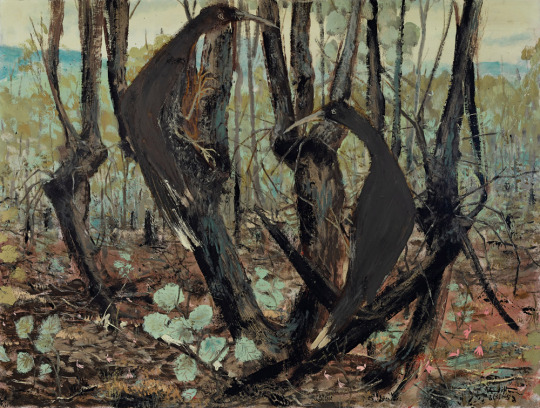
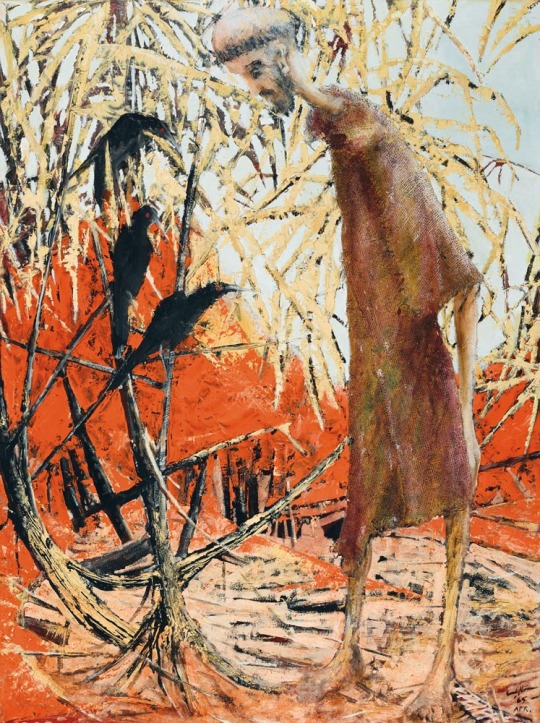
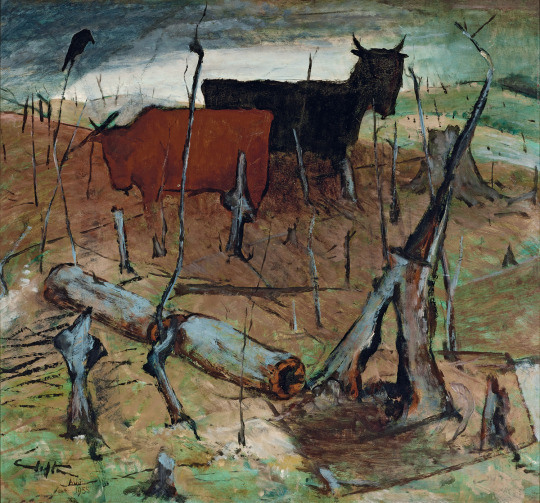
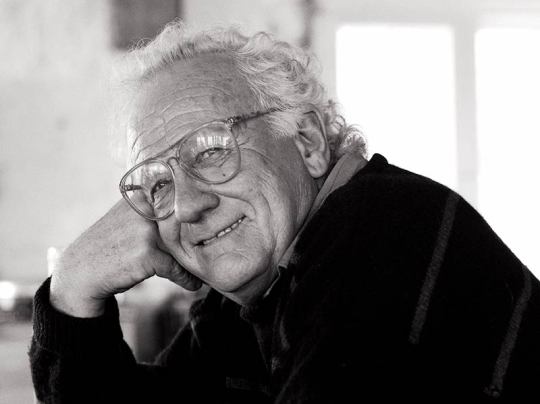
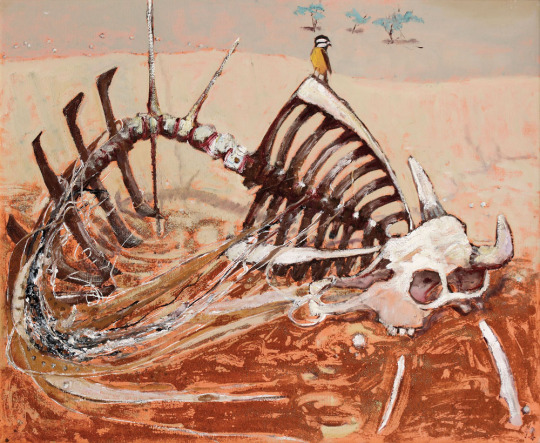

Clifton Pugh (1924 – 1990) was an Australian artist and three-time winner of Australia's Archibald Prize. One of Australia's most renowned and successful painters, Pugh was strongly influenced by German Expressionism, and was known for his landscapes and portraiture. Important early group exhibitions include The Antipodeans, the exhibition for which Bernard Smith drafted a manifesto in support of Australian figurative painting, an exhibition in which Arthur Boyd, David Boyd, John Brack, Robert Dickerson, John Perceval and Charles Blackman showed; a joint exhibition with Barry Humphries, in which the two responded to Dadaism; and Group of Four at the Victorian Artists Society Gallery with Pugh, John Howley, Don Laycock and Lawrence Daws.
Frank Neilson, photographer, tells about his visit to Clifton Pugh:
Clifton Pugh, one of Australia’s most celebrated artists and three-time winner of the Archibald Prize for portraiture, lived on his 15 acre property “Dunmoochin” at Cottle’s Bridge in country Victoria. Clifton, born in Melbourne on 17 December 1924, was a prolific painter and print-maker of landscape and portrait subjects. He received the honour of Officer of the Order of Australia for his services to art. A staunch supporter of the Australian Labor Party, one of his memorable Archibald wins was for his 1972 painting of Labor Prime Minister Gough Whitlam.
"I first saw one of Clifton’s paintings during the early sixties, and was impressed by the very “Australian” style he used. That painting was of the carcase of a dead animal in the desert, painted in strong yellows and reds, with expressionistic black outlining. I got to know Clifton in about 1988, whilst photographing a series of works he had produced on the theme of Leda and the Swan; for which I used a studio lighting technique I had developed which correctly threw the brush-strokes into relief. They were made into high-quality posters, which Clifton loved, saying that they looked as good as the originals." Continue https://frankneilsen.com.au/gallery/clifton-pugh
10 notes
·
View notes
Text
The Price May Be Right - Number 13
Welcome to “The Price May Be Right!” I’m counting down My Top 31 Favorite Vincent Price Performances & Appearances! The countdown will cover movies, TV productions, and many more forms of media. Today we focus on Number 13: Dr. Phibes.
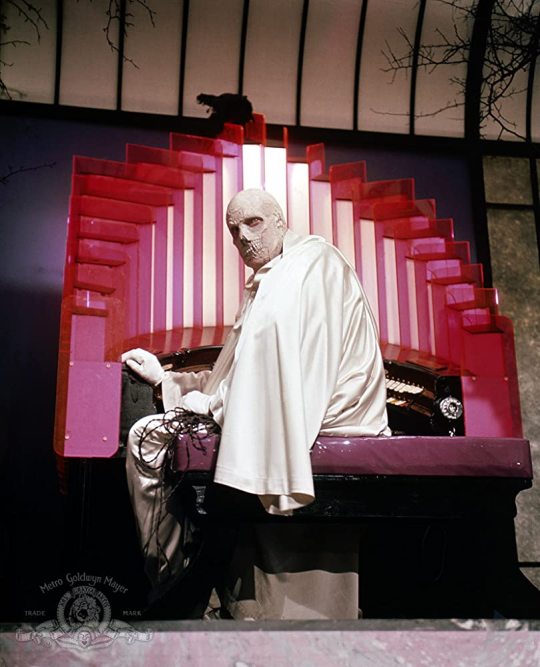
So, here’s a random fun fact for you Batman fans out there: apparently, this character was the inspiration for the version of Mr. Freeze that appeared in the seminal animated story, “Heart of Ice.” And, of course, that version of Mr. Freeze would become the inspiration for the character in nearly every other interpretation – both in and out of comics – to date. So, yeah, if you’re a Mr. Freeze fan, you can thank Egghead for it. :P ANYWAY…while Vincent did many, MANY horror movies – both serious and comedic alike – the one thing he never got was the chance to play a horror icon, so to speak. Which is to say, when you look at other great classic horror actors over the years, whatever else they do there’s always one specific character for whom they’ll always be remembered. For Christopher Lee and Bela Lugosi, it was Count Dracula; for Boris Karloff, it was Frankenstein’s Monster; even with more modern actors, like Roger L. Jackson and Robert Englund, they have specific horror roles (The Voice of Ghostface and Freddy Krueger, respectively) for which they will always be most chiefly recognized. Vincent never had that; he never got that recognition of having a specific, classic monster he could be identified with. The closest we ever got was that he was so well-known for his work with the stories of Edgar Allan Poe, but that’s a bit of a different issue. However, in the 1970s, Price DID get a chance to ATTEMPT such a feat, in two films that were part gruesome, gory nightmare fuel and part witty, satirical humor-fests: these were the Dr. Phibes films. The titular character was a deranged musical genius, who wore a mask to hide his hideous skull-like deformities – all elements taken from the timeless tale of “The Phantom of the Opera.” However, the story of the good doctor is rather different: Phibes’ descent into evil began when his beloved wife, Victoria, was stricken with some unholy medical condition. In order to save her life, a risky surgical operation was needed, which was so tricky it required the aid of no less than nine people to even hope for a success. Unfortunately, something went wrong with the operation; as soon as he got the news, Phibes hurried in the direction of the hospital…but was ironically caught in a terrible car crash, and apparently burned to death in the wreck. Husband and wife were then interred together. The rumors of Dr. Phibes’ death, however, were greatly exaggerated. Phibes miraculously survived the crash, and later rose from the grave hideously disfigured by the accident. He brought his wife with him, and kept her body imprisoned in a sarcophagus filled with honey and special fluids, so that her beauty would forever remain intact. In the first film, “The Abominable Dr. Phibes,” the mad maestro goes on a killing spree, attempting to get revenge on the nine people he blames for the death of his wife and the ruination of his existence. In the second film, “Dr. Phibes Rises Again,” the musical maniac returns, now seeking to resurrect his beloved bride. The Phibes films were a bizarre sort of pair. In a way, I sort of see these as the precursor to both the Scream films and the SAW movies. Like the former films, the movies combine elements of parodical dark comedy with real chills and gory, brutal death scenes. Phibes, himself, is treated as a serious and tragic character, and the fear factor is upped by his appearance. The mask he wears to hide his deformities is basically just Vincent’s face with some uncanny valley makeup added to enhance the effect, giving Price a particularly ghoulish appearance. This combined with the special voice box Phibes uses to speak after his accident – which causes Price to speak in a robotic, mechanical, droning sort of way that is both odd and genuinely unsettling – makes the character truly chilling. At the same time, however, he’s a sympathetic villain, as everything he does is in the name of his precious Victoria, and while one recognizes he is the bad guy of the story, it’s hard not to feel sorry for him and understand his motivations. The methods through which he offs his victims are pretty messed up even by today’s standards, too. In all, I would say most of the scares from the film come from Phibes himself. The humor generally is the result of the other characters around him, as well as some the intentionally contrived elements of the plot that are meant to satirize various horror movie tropes. I’m a little surprised there weren’t more films in the Phibes franchise; if there had been, maybe Vincent could have had that one iconic horror character to be recognized by…but, on the other hand, one of the things that made Vincent so fascinating was that he wasn’t someone who could fit into a singular mold, so to speak, and instead had MANY roles for which any given person could recognize him for most keenly. Dr. Phibes was ultimately just one of those parts, but it’s a part well worth remembering. Tomorrow, the countdown continues with Number 12!
#list#countdown#best#favorites#top 31 vincent price performances#the price may be right#vincent price#actors#acting#horror#comedy#dark comedy#dr. phibes#the abominable dr. phibes#dr. phibes rises again#number 13#movies#film
11 notes
·
View notes
Text
Events 6.16 (before 1910)
632 – Yazdegerd III ascends the throne as king (shah) of the Persian Empire. He becomes the last ruler of the Sasanian dynasty (modern Iran). 1407 – Ming–Hồ War: Retired King Hồ Quý Ly and his son King Hồ Hán Thương of Hồ dynasty are captured by the Ming armies. 1487 – Battle of Stoke Field: King Henry VII of England defeats the leaders of a Yorkist rebellion in the final engagement of the Wars of the Roses. 1632 – The Plymouth Company granted a land patent to Thomas Purchase, the first settler of Pejepscot, Maine, settling at the site of Fort Andross. 1745 – War of the Austrian Succession: New England colonial troops under the command of William Pepperrell capture the Fortress of Louisbourg in Louisbourg, New France (Old Style date). 1746 – War of the Austrian Succession: Austria and Sardinia defeat a Franco-Spanish army at the Battle of Piacenza. 1755 – French and Indian War: The French surrender Fort Beauséjour to the British, leading to the expulsion of the Acadians. 1760 – French and Indian War: Robert Rogers and his Rangers surprise French held Fort Sainte Thérèse on the Richelieu River near Lake Champlain. The fort is raided and burned. 1779 – American Revolutionary War: Spain declares war on the Kingdom of Great Britain, and the Great Siege of Gibraltar begins. 1795 – French Revolutionary Wars: In what became known as Cornwallis's Retreat, a British Royal Navy squadron led by Vice Admiral William Cornwallis strongly resists a much larger French Navy force and withdraws largely intact, setting up the French Navy defeat at the Battle of Groix six days later. 1811 – Survivors of an attack the previous day by Tla-o-qui-aht on board the Pacific Fur Company's ship Tonquin, intentionally detonate a powder magazine on the ship, destroying it and killing about 100 attackers. 1815 – Battle of Ligny and Battle of Quatre Bras, two days before the Battle of Waterloo. 1819 – A major earthquake strikes the Kutch district of western India, killing over 1,543 people and raising a 6-metre-high (20 ft), 6-kilometre-wide (3.7 mi), ridge, extending for at least 80 kilometres (50 mi), that was known as the Allah Bund ("Dam of God"). 1824 – A meeting at Old Slaughter's coffee house in London leads to the formation of what is now the Royal Society for the Prevention of Cruelty to Animals (RSPCA). 1836 – The formation of the London Working Men's Association gives rise to the Chartist Movement. 1846 – The Papal conclave of 1846 elects Pope Pius IX, beginning the longest reign in the history of the papacy. 1858 – Abraham Lincoln delivers his House Divided speech in Springfield, Illinois. 1871 – The Universities Tests Act 1871 allows students to enter the universities of Oxford, Cambridge and Durham without religious tests (except for those intending to study theology). 1883 – The Victoria Hall theatre panic in Sunderland, England, kills 183 children. 1884 – The first purpose-built roller coaster, LaMarcus Adna Thompson's "Switchback Railway", opens in New York's Coney Island amusement park. 1897 – A treaty annexing the Republic of Hawaii to the United States is signed; the Republic would not be dissolved until a year later. 1903 – The Ford Motor Company is incorporated. 1903 – Roald Amundsen leaves Oslo, Norway, to commence the first east–west navigation of the Northwest Passage. 1904 – Eugen Schauman assassinates Nikolay Bobrikov, Governor-General of Finland. 1904 – Irish author James Joyce begins a relationship with Nora Barnacle and subsequently uses the date to set the actions for his novel Ulysses; this date is now traditionally called "Bloomsday".
1 note
·
View note
Text
Lost Boy
This week, our Art Therapy blogger, Victoria, shares some of the fan art that she created based off of Batman! She chose a specific character, Jason Todd, and created an illustration inspired by this character. Check it out! #MarywoodArt
The entirety of my winter break consisted of me playing the Arkham Batman series on XBox during my free time. I’ve always enjoyed watching superhero movies, Batman being no exception with the Christopher Nolan trilogy, the recent The Batman film featuring Robert Pattinson, and the DC animated universe movies. I’ve seen gameplay, commentary, and reviews for the Arkham series which convinced me to…
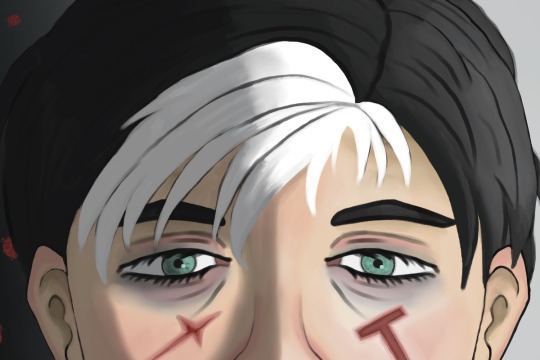
View On WordPress
#2d art#Art#batman#dc comics#digital art#Illustration#inspiration#jason todd#joker#Marywood Art#Marywood Art Department#Marywood University#Marywood University Art Department#portrait#procreate app#red hood#robin#under the red hood#Where Creativity Works
2 notes
·
View notes
Text
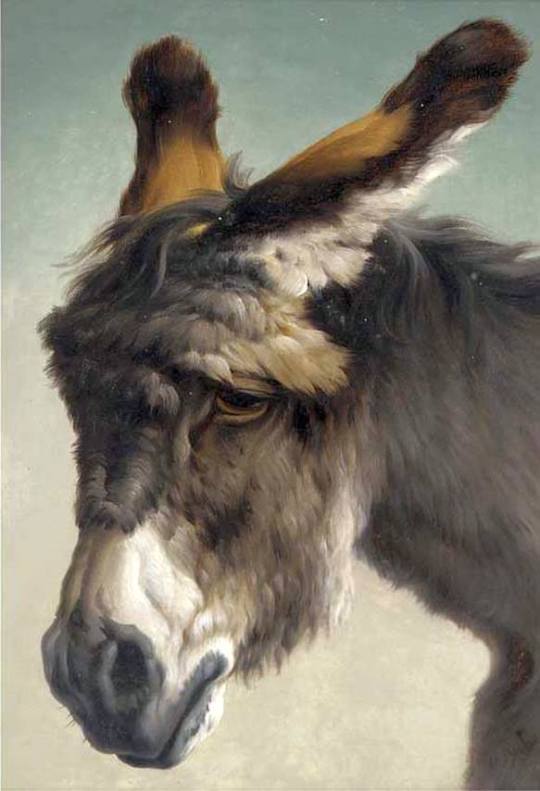
Rosa Bonheur (French painter and sculptor) 1822 - 1899 The Forlorn Donkey, ca. 1881 oil on paper laid down on canvas 35.7 x 25.5 cm. (14.25 x 10 in.) signed 'Rosa Bonheur' (lower right) private collection © photo Christie's
Rosa Bonheur made another version of this donkey, Head of a Donkey, 1881, oil on panel, 29.5 x 25 cm.
* * *
Rosa Bonheur was a French animalière, realist artist, and sculptor. As a painter she became famous primarily for two chief works: Ploughing in Nevers and The Horse Fair (in French: Le marché aux chevaux) (which was exhibited at the Salon of 1853 (finished in 1855) and is now in the Metropolitan Museum of Art, in New York City. Bonheur is widely considered to have been the most famous female painter of the nineteenth century.
Bonheur was born in Bordeaux (where her father had been friends with Francisco Goya who was living there in exile) but moved to Paris in 1828 at the age of six with her mother and brothers, her father having gone ahead of them to establish a residence and income. By family accounts, she had been an unruly child and had a difficult time learning to read. To remedy this her mother taught her to read and write by having her select and draw an animal for each letter of the alphabet. To this practice in the company of her doting mother she attributed her love of drawing animals.
Although she was sent to school like her brothers, she was a disruptive force in the classroom and was consequently expelled from numerous schools. Finally, after trying to apprentice her to a seamstress Raimond agreed to take her education as a painter upon himself. She was twelve at that point and would have been too young to attend the École des Beaux-Arts even if they had accepted women. As was traditional in the art schools of the period, Bonheur began her artistic training by copying images from drawing books and by sketching from plaster models. As her training progressed she began to make studies of domesticated animals from life, to include horses, sheep, cows, goats, rabbits and other animals in the pastures on the perimeter of Paris, the open fields of Villiers[disambiguation needed] and the (then) still-wild Bois de Boulogne. At age fourteen she began to copy from paintings at the Louvre. Among her favorite painters were Nicholas Poussin and Peter Paul Rubens, but she also copied the paintings of Paulus Potter, Porbus, Louis Léopold Robert, Salvatore Rosa and Karel Dujardin. She also studied animal anatomy and osteology by visiting the abattoirs of Paris and by performing dissections of animals at the École nationale vétérinaire d'Alfort, the National Veterinary Institute in Paris. There she prepared detailed studies which she would later use as references for her paintings and sculptures. During this period, too, she also met and became friends with the father and son comparative anatomists and zoologists Étienne Geoffroy Saint-Hilaire and Isidore Geoffroy Saint-Hilaire by whom her father was employed to create natural history illustrations.
Rosa Bonheur received a French government commission which led to her first great success, Ploughing in the Nivernais, exhibited in 1849. Her most famous work was the monumental Horse Fair, completed in 1855, which measured eight feet high by sixteen feet wide. Its subject is the horse market held in Paris on the tree-lined boulevard de l’Hôpital, near the Pitié-Salpêtrière Hospital, visible in the background on the left. It led to international fame and recognition and that same year she travelled to Scotland, "en route" meeting Queen Victoria, who admired her work, and where she completed sketches for later works including A Scottish Raid, completed in 1860, and Highland Shepherd. These were anachronistic pieces as they depicted a way of life in the Scottish highlands that had disappeared a century earlier. Nonetheless, they had enormous appeal to Victorian sensibilities. She was especially popular in England, though less so in her native France. In France she was decorated with the Legion of Honour by the Empress Eugenie and was promoted to officer of the order.
She was represented by private art galleries, and in particular that of Ernest Gambart (1814–1902), who would purchase the reproduction rights to her work and sell engraved copies of her paintings. It was Gambart who brought Bonheur to the United Kingdom in 1855. Many engravings were created by the skillful Charles George Lewis (1808–1880), one of the finest engravers of his day. Gambart sold through his gallery in London's Pall Mall.
Due to a tendency in 1980s-1990s academic criticism to locate Bonheur as a proto-Feminist and as a pivotal figure for Queer theory, she is perhaps most famous today because she was known for wearing men's clothing and living together with Anna Klumpke. Her work and artistic talent has now become somewhat secondary in importance to her manner of dress, her choice of companions and her penchant for smoking cigarettes. On her wearing of trousers, she said at the time that her choice of attire was simply practical as it facilitated her work with animals: "I was forced to recognize that the clothing of my sex was a constant bother. That is why I decided to solicit the authorization to wear men's clothing from the prefect of police. But the suit I wear is my work attire, and nothing else. The epithets of imbeciles have never bothered me...." She lived for over forty years with her childhood friend Nathalie Micas. In the final year of her life she became close with Anna Klumpke, the author of her "autobiography". She died at the age of 77, at Thomery (By), France. Many of her paintings, which had not previously been shown publicly, were sold at auction in Paris in 1900.
Source: Wikipedia
7 notes
·
View notes
Photo

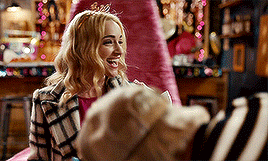
Task #002 - A Few of my Favorite Things
Food and Drink
Favorite fast food restaurant? Wendy’s
Favorite ice cream flavor? Ben & Jerry’s Half Baked
Favorite chocolate candy? Peanut M&Ms
Favorite fruity candy? Starbursts
Favorite kind of sushi? Sashimi
Favorite Asian dish? Chow mien
Favorite Italian dish? Carbonara
Favorite food of all time? Her grandmother’s chicken pot pie
Favorite pizza topping? Pepperoni
Favorite breakfast food? Fried eggs, hashbrowns, sausage, and toast
Favorite fruit? Strawberries and peaches
Favorite vegetables? Green beans
Favorite comfort food? Grilled cheese
Favorite dessert? Strawberry shortcake and peach cobbler
Favorite dish at Thanksgiving? Stuffing
Favorite thing to cook? Anything someone she loves likes
Favorite drink? Peach lemonade
Favorite alcoholic drink? Brachetto D'acqui wine
Favorite flavor coffee? Hazelnut
Television and Movies
Favorite ‘80s movie? Pretty in Pink
Favorite Harry Potter movie? Half-blood Prince
Favorite TV sitcom? Saved by the Bell
Favorite cartoon? Josie & The Pussycats
Favorite scary movie? Jennifer’s Body
Favorite funny movie? She’s the Man
Favorite celebrity? Julia Roberts
Favorite chick flick? Pretty Woman
Favorite Pixar movie? Wall-E
Favorite Disney movie? Sleeping Beauty
Favorite actress over 50? Meryl Streep
Favorite Marvel movie? She hasn’t really seen them
Favorite TV show? Gilmore Girls
Favorite movie? Pretty Woman
Favorite classic movie? Breakfast at Tiffany’s
Music
Favorite band or music artist? Shania Twain
Favorite music genre? Pop-country
Favorite ‘80s song? Girls Just Wanna Have Fun by Cyndi Lauper
Favorite song? Man! I Feel Like a Woman by Shania Twain
Travel and Recreation
Favorite state you’ve visited? Connecticut
Favorite country you want to visit? France
Favorite vacation location? Coastal town, Universal Studios
Favorite way to travel? Driving
Favorite place to go with family? The beach
Favorite vacation you’ve taken? Universal Studios for the twins’s 11th birthday
Favorite fictional place you’d want to visit? Hogwarts
Nature and Animals
Favorite breed of dog? Yellow lab retriever
Favorite season? Summer
Favorite flower? Peony
Favorite animal at the zoo? Giraffes
Favorite thing about a rainy day? How green everything looks (in the spring)
Favorite thing about spring? The flowers
Favorite thing about summer? Kids are out of school
Favorite thing about fall? Leaves changing, pumpkin spice lattes
Favorite thing about winter? Ice skating, hot chocolate, Christmas
Favorite animal? Starfish
Sports
Favorite sport? Soccer (because of the twins)
Favorite extreme sport you’re too scared to do? Cliff diving
Favorite Olympic sport? Ice skating
Favorite winter sport? Ice skating
Favorite sport as a hobby? Swimming
Favorite sports team? New York Giants
Childhood
Favorite nursery rhyme? Hush Little Baby
Favorite childhood memory? Sleepovers with friends, going to Camp Morningstar
Favorite board game? Life
Favorite toy as a child? Sky Dancers
Favorite thing about school? Being with her friends & Johnny
Favorite age? Seventeen
Favorite Christmas present? Spice Girl dolls
Favorite Dr. Seuss book? Green Eggs & Ham
Favorite Halloween costume you’ve worn? Princess Aurora
Favorite superhero? Wonder Woman
Favorite fairy tale? Rapunzel
Favorite game to play outside? Red Rover
Fashion and Beauty
Favorite place to shop? Target
Favorite perfume/cologne? Bare Vanilla from Victoria’s Secret
Favorite hair color? Blonde
Favorite makeup you can’t live without? Toner
Favorite shoes? Heels
Favorite occasion to dress up for? Weddings
Favorite hairstyle? ( x )
Favorite outfit you have? For work ( x ) / For home ( x )
Favorite soap scent? Strawberry & Vanilla Taffy by Native
Favorite article of clothing? Comfy sweaters
Favorite piece of jewelry? Her engagement ring, a necklace the twins gave her
Favorite thing to wear to bed? One of Johnny’s shirts and shorts
Other
Favorite book? A Little Princess by Frances Hodgson Burnett
Favorite video game? The Sims (when she was young)
Favorite holiday? Christmas
Favorite decade? 00s
Favorite candle scent? Sugar cookie
Favorite hobby? Baking, dancing
Favorite way to relax? Watching a movie with the family, girls nights, baking, yoga
Favorite place to meet up with friends? Her house, Patty’s
Favorite color? Powder blue
1 note
·
View note